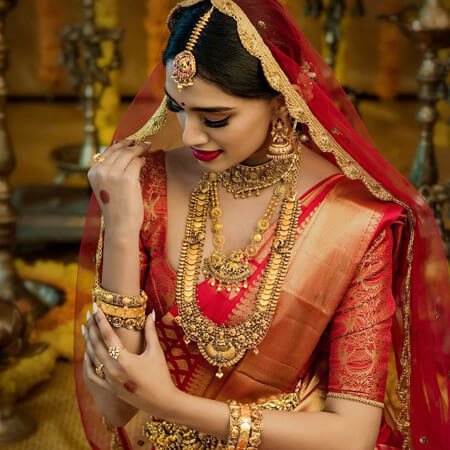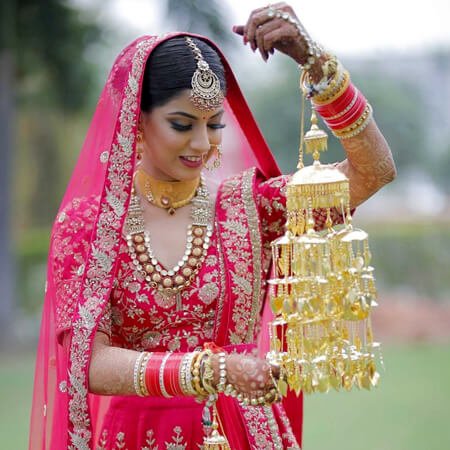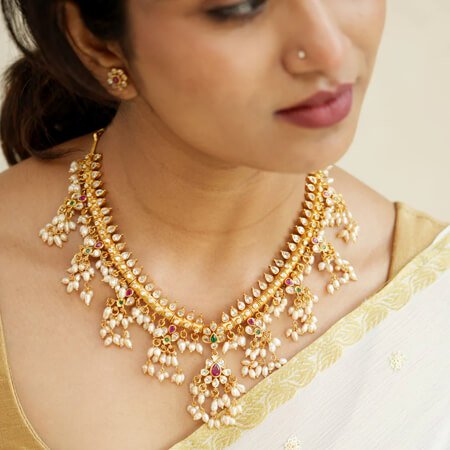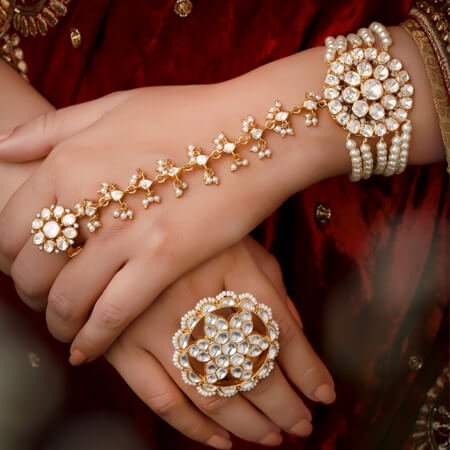Traditional Indian Jewellery & its Deep Cultural Roots
A Cultural Canvas Woven in Gold and Gemstones
Jewellery in India is more than a means of adornment. It is memory. It is culture. It is identity carried through generations. Every region of the country has its own signature pieces that tell a story - from birth ceremonies to weddings and festivals. Think of the glistening Kundan sets of Rajasthan or the divine Temple jewellery of Tamil Nadu. Each piece holds religious, social, or familial significance. Wearing jewellery here is often a form of expression, deeply tied to beliefs and customs. These ornaments are rarely chosen just for style. There’s usually a reason—sometimes sacred, sometimes emotional. The colours, the stones, the motifs—they all speak of a deeper connection to something greater. Whether it’s the auspicious Mangalsutra or the Kalire that dangle from a Punjabi bride’s wrists, every detail has meaning, often going beyond the person wearing it.
Read more about Traditional Indian Jewellery: A Journey Through Culture and Craftsmanship
Timeless Techniques That Still Shine Bright
What makes Traditional Indian Jewellery so unique is the intricate craftsmanship passed down through centuries. Entire communities of artisans, or karigars, have kept age-old methods alive with their bare hands and simple tools. The meenakari work of Varanasi, for example, layers coloured enamel over gold in elaborate designs. Guttapusalu from the South is another classic, with pearl clusters arranged in fish-tail patterns, once worn only by royals. These aren't just techniques—they’re heirlooms of heritage. Artisans invest hours, sometimes days, crafting each piece. Even the tools they use have been handed down. There’s no mass production here. Just precision, patience, and pride. And in an age when speed dominates most industries, that kind of devotion is rare. This makes every necklace or earring not just jewellery, but a personal piece of history.
A Journey Through Regions and Rituals
Travel through India, and you’ll notice that jewellery traditions shift with every state. In Bengal, women wear the Chandrahar and Ratanchur—ornaments shaped like the moon and sun, often reflecting their regional spiritual beliefs. In Maharashtra, brides are adorned with the green glass bangles called Chooda, paired with heavy nathni nose rings. Down South, the Vaddanam, or gold waist belt, is a staple in bridal wear, often passed on by mothers and grandmothers. These designs are more than fashion. They reflect the weather, the culture, the rituals, and even the economy of the region. What’s considered auspicious in one place may be entirely different in another. But across all these differences, one thing remains constant—the pride of wearing something that belongs to your roots. You don’t just wear it. You live in it. You carry your ancestors with you.
The Symbolism Behind Every Sparkle
Indian jewellery isn’t only tied to beauty. Most of it holds spiritual or emotional value. Temple jewellery, often gifted during religious events, is designed with images of gods and goddesses. These are not worn casually. They’re revered. The Kalire worn by brides symbolise prosperity and good luck. The Mangalsutra signifies marital commitment and is often considered a sacred bond rather than a mere ornament. Even simple toe rings or anklets carry messages about a woman’s life stage or social status. The designs are layered with meanings and beliefs that add emotional depth to every piece. And when you think about it, that’s what makes it so powerful. A necklace isn't just a necklace. It's protection, it's pride, it's prayer.
Preserving the Craft in a Modern World
While modern fashion trends shift by the minute, traditional Indian jewellery has managed to hold its place, standing tall in bridal closets and festive wardrobes. But preserving these crafts isn’t just about wearing them. It’s about supporting the artisans who still create with their hands. The demand for machine-made pieces is rising, but the beauty and soul of handcrafted jewellery can’t be replicated. There is a slow but steady movement back towards appreciating slow fashion, and traditional jewellery is playing a huge role in that. Younger generations are now pairing heritage jewellery with modern outfits, creating a beautiful blend of the old and the new. And that’s the future of this craft - evolution without losing its roots.
Warm Greetings,
Fashion Articles by Waves Institute of Fashion Designing
#traditionaljewellery #indianheritage #culturalfashion #ethnicstyle #handcraftedindia #indiantemples #bridaljewellery #jewelleryartisans #timelesscraft #ethnicjewellery



